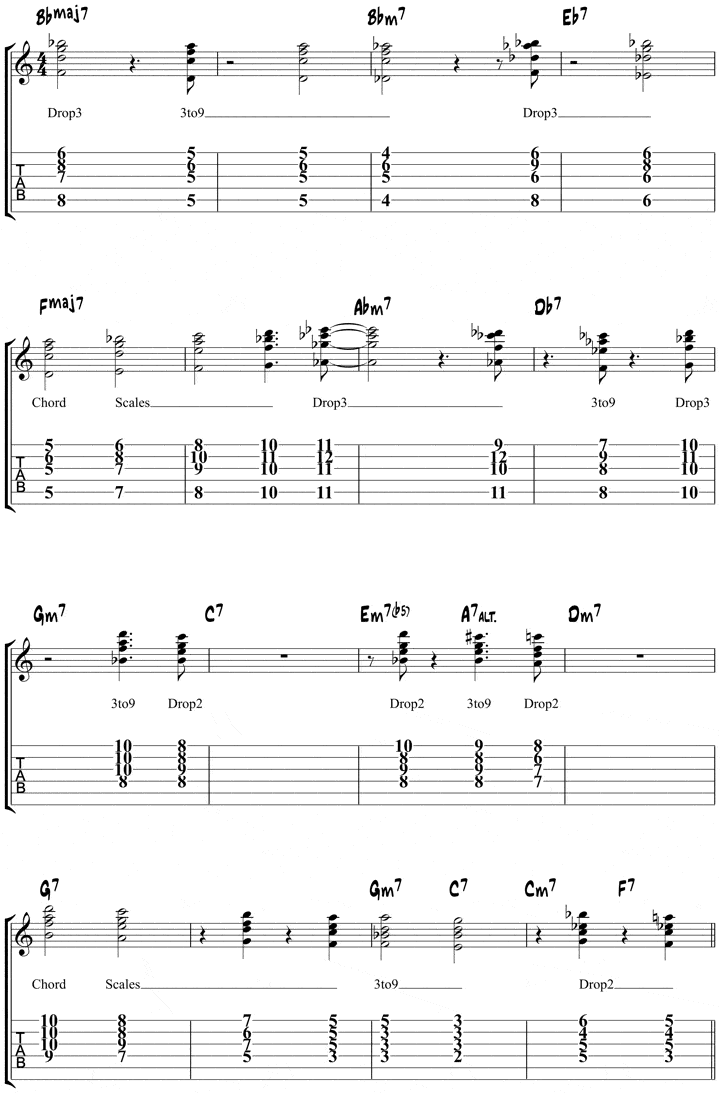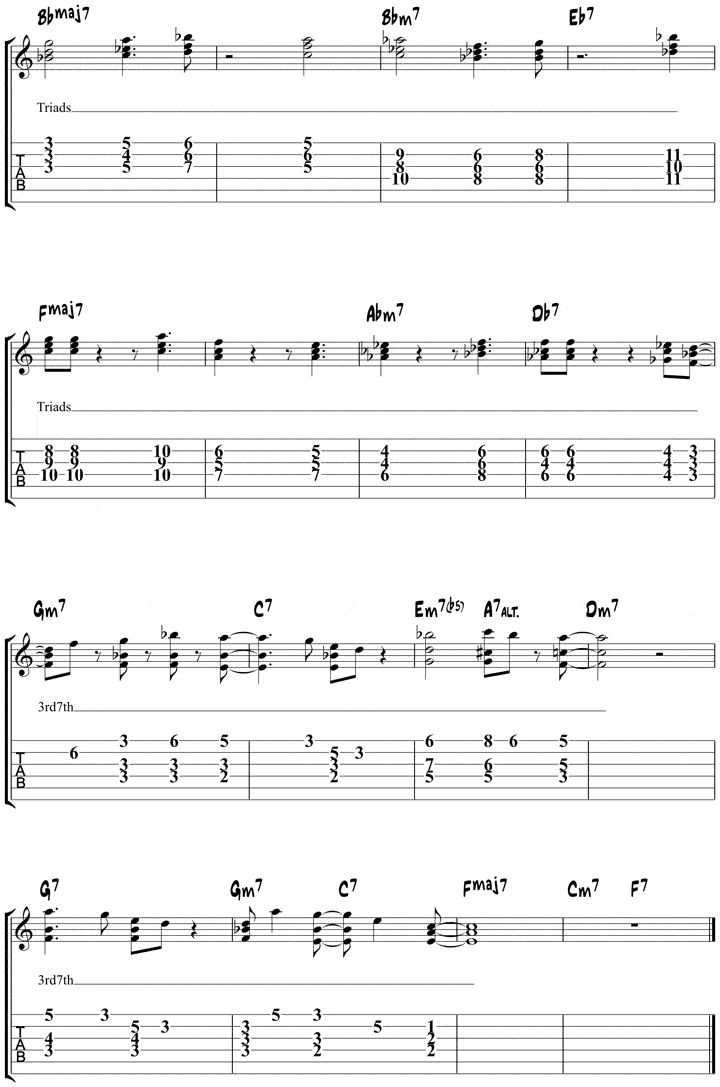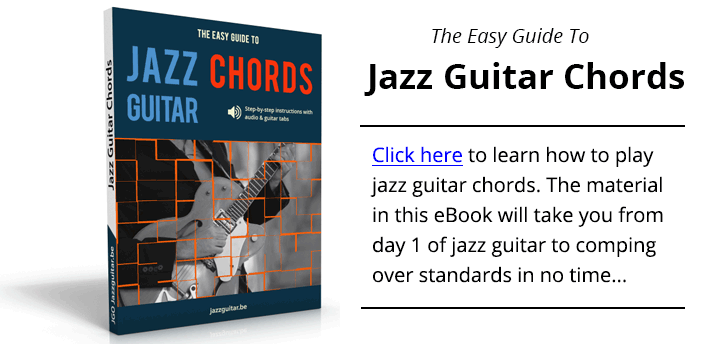Just Friends is a classic jazz standard that is often called at jazz jam sessions and pick-up gigs. Because of this, having a strong understanding of the Just Friends chords will come in handy when jamming on this tune in a jazz combo setting.
The chord study in this lesson will help you build your confidence with this jazz standard, as well as expand your jazz chord vocabulary. Both will better prepare yourself the next time someone calls this tune on a jam or gig.
Before you get started, you should know that Just Friends gets called in a few different keys, mostly F and G. The chord study in this lesson is in the key of F, which is the key Pat Martino played this tune in on his legendary “El Hombre” record.
Once you have this study under your fingers, you can study Just Friends in G in order to ensure you have all your bases covered.
What’s In This Chord Study
Before you learn how to play the chord study below, learn a bit more about the concepts behind these chords. Each of the chord concepts in the study is explained in this section as an introduction to the main ideas behind the comping etude.
So, if you enjoy or are curious about any of these concepts, feel free to expand on them further in your studies.
Drop 3 Chords
One of the most common jazz guitar chords, drop 3 shapes are made with the interval pattern 1-7-3-5, with the inversions built up from there.
As there’s a bass player on the backing tracks, these drop 3 shapes use the string set 5321 to avoid as many clashes as possible with the bass player.
When using drop 3 chords in your comping, be aware that these chords often use 6 and 5th- string root notes in their construction, which can clash with bass lines. Though you need to be cautious with drop 3 chords in a group context, when playing solo, duo, or in a bassless group, these shapes are often your go-to chords.
3 to 9 Chords
The further you explore jazz guitar comping, the more important 3 to 9 chords will become in your playing.
These chords are built by playing the 3rd, 5th, 7th, and 9th of the chord you’re on, essentially replacing the root with the 9th of any chord you’re playing. When doing so, you’ll be able to use chords you know in a new context to form a rootless 9th chord sound on the guitar.
For example, playing a minor 7 chord from the 3rd of a maj7 chord produces a 3 to 9 maj7 sound.
As you work through these shapes, keep a record of which known chords fit over the underlying changes to produces various 3 to 9 sounds. This will allow you to apply 3 to 9 chords to any musical situation as you apply this concept to other keys, chords, and tunes.
Drop 2 Chords
Another popular jazz guitar chord shape, Drop 2 chords are built with the interval pattern 1-5-7-3, and inversions created from that initial shape.
Drop 2 chords are effective when playing with bass players, as they can be played on the top-4 string set, which you see in this study. Because they can fit on the top-4 strings, drop 2 chords cut through the sound of a jazz combo, while at the same time staying out of the way of the bass player.
One thing to keep in mind with these chords shapes is that when you do play them in the higher range, you don’t step on the melody line with your voicings.
If you’re playing drop 2 chords behind a vocalist for example, or any chord shape for that matter, be aware of the melody line they’re singing. Drop 2 chords can be effective, but if the singer is holding a root note, and you’re holding a chord with the 7th as the upper note, that’s going to clash.
Chord Scales
Chord scales are created by harmonizing the notes of any given scale with two or more notes below those scale notes.
When using chord scales, you’re staying within the key center, but are creating new colors over the chord changes without stepping outside the diatonic harmony.
As chords move by quickly in many jazz standards, you’ll need to pick your moments to use chord scales carefully. It’s easy to get caught up playing a chord scale too long and missing the next chord change in the progression, which can cause harmonic clashes.
If you dig chord scales, explore them further, just make sure to work on applying them as much as learning them to avoid any bum notes when comping over tunes.
Diatonic Triads
Diatonic triads are similar to chord scales, in that you’re playing triads from the key you’re in to create various colors over the chord changes. When doing so, you can use any triad in any inversion from the key of the chord you are comping over, which is a pretty wide open approach to comping.
Because of this, experiment at home first before using diatonic triads in a jam or gig situation.
Though in theory, all diatonic triads will fit over any diatonic chord change, some will sound better than others in certain situations. Experiment over backing tracks to figure out how you like to use diatonic triads in your playing before using them on the bandstand.
3rds and 7ths
These chord shapes are built with the 3rd and 7th of any chord change as the lowest two notes in the shape.
You can either play only the 3rd and 7th, which is an effective way to comp when playing with a pianist, or add color tones on top of those two notes.
In this study, as there’s no pianist on the backing track, you’ll add diatonic color tones on top of each 3rd and 7th in the lower part of the chord.
One of the reasons that this approach is so powerful when comping, is that you can create complex sounding lines by moving upper notes over a static lower pair. This is easier than creating movement by playing one new chord shape for each melody note in your comping lines.
Because of this, if you’re exploring chord soloing or chord melody in your practice routine, 3rd and 7th shapes are an essential study.
Just Friends Chords – Comping Study
Now that you know what’s in the chord study, it’s time to get this etude under your fingers and onto your guitar.
As you learn to play these Just Friends chords, it’s best to start by working on one phrase at a time. You can work on two or four bars with each phrase in order to break down the longer study into more manageable chunks.
When working on these smaller phrases, go slow, work out the shapes first with a metronome, then when you’re ready you can play along to the example track.
There’s also a Just Friends backing track that you can use to practice the chord study, or to comp over using these shapes as the basis for your chord work.
Learning chord studies is fun and beneficial, but the real learning occurs when you take these chords and concepts and use them to create your own comping lines and phrases over jazz standards.
Backing Track
Listen & Play Along





play drop2 chord shapes in the higher range, what does it mean?
I love to see how you finger these chords…they are unfamiliar to me.
Is there a PDF. This is a great study!
Thanks, just click “print screen” then “save as pdf” in your browser to create a pdf of hte lesson. Cheers.
Nice guys…sounds Joe Passish.
more really good stuff Matt. thanx.
Hi Matt
I THINK THE REALBOOKTONALITY IS GMAJOR FOR “JUST FRIENDS” I SAH THIS ALSO IN CMAJOR.
IN THE BAND I PLAY BEVOR IT IS IN FMAJOR. THE ARRANGEMANT IS NICE.WHAT DO YOU THINK?
I PLAY THIS TUNE NOW IN Bb??
Thanks a lod
Dolf
Hey, this arrangement is in F major, the first chords of Just Friends is the IV chord. So when you play it in G major, the first chord is Cmaj7. Hope that helps. Cheers.
Why is the Bb maj 6 called a major 7th?
Hey, maj7 and 6 chords come from the same family, major, so are often played interchangeably. Check out this lesson for more info on that topic.
https://www.jazzguitar.be/reading-jazz-chords.html
Bb major6 seems an odd choice given that the melody note is A, the major 7th.